With most working Americans spending at least one-third of their days and nights on the job, an increasing number of employers are actively investing in an improved “normal” for their primary work spaces.
Donna Burnell, managing director of enterprise workplace services at Fifth Third Bank, has been shepherding such an effort at the company since spring of 2016. Making their way through a portfolio of more than 200 bank office buildings ranging in size from 10,000 to 650,000 square feet, she and her team are juggling more than a dozen renovations at any given time. The program—called OurWorkplace—is creating more open and flexible office spaces that incorporate the bank’s core values and culture, maximize natural light, and feature ergonomic furniture.
The shift is particularly important now that millennials make up almost 50 percent of Fifth Third’s workforce. They are not only the world’s largest demographic, but also the bank’s largest demographic.
And, judging from employee feedback, it’s clear Burnell and her team have already made a difference. Surveys have found that employees who have made the move to the new office spaces—regardless of age or demographic—don’t want to return to cubicles and offices. “Our employees say they look forward to working in the office,” Burnell says. “They love that they can curate their own day, sitting in the best place to get their work done. They work differently, and our job is to create environments that give them variety, choice, and flexibility that support their most productive day.”

Burnell says her team has continued to talk with employees as they’ve moved into the newly designed spaces, to make adjustments along the way. And, Fifth Third has helped employees to transition to the new spaces through a new change-management team, a variety of forums including town hall meetings and one-on-one conversations, and training with new technology. What helped the most, Burnell says, was that people were already changing the way they worked before the office space changed. “We had more collaboration and agile teams, so our employees were happy when the office changed to accommodate the way they like to work,” she says. “We wanted them to know the changes were to enable them to do their work in new ways.”
Here, Burnell offers a review of the key changes.
1) Variety, choice, flexibility
In the banking industry, Burnell says, as much as 30–40 percent of traditional work space goes unused at any given time. Sometimes it’s because of employee absences due to illness or vacation; other times, a worker may simply spend more time in the field or at another location in the building. So, one goal of Fifth Third’s upgrades is relatively simple: move away from assigned offices and toward open, collaborative environments.
“We’re creating an experience,” Burnell says. “It’s not just about cool spaces with plenty of sticky notes and rewriteable surfaces on hand but about using space to highlight, emphasize, and impact culture. It’s less about formal meetings and more about what we like to call ‘accidental collisions.’”
The new spaces offer flexibility, allowing employees to choose how to curate their day based on their work. There are areas with traditional desks and others with open seating. There are couches with tables for employees to kick up their feet and write, there are quiet rooms and huddle rooms for focus and confidentiality, and there are open spaces to write on white walls and collaborate. The idea is to have a variety of spaces so that regardless of what employees are working on, they can move to spaces that make the most sense.

2) Fostering Employee Wellness
“Everyone has the right to natural light,” Burnell says, noting that, historically, it’s been relegated to corner offices. “It’s a big part of the standards we incorporate into every build-out.”
Those standards are about more than just ample natural light, though; they’re also about adjustable desks that encourage movement—as well as treadmills, ping-pong tables, and foosball tables. Obviously, the rules for “work” are not what they used to be. “Play is associated with building relationship skills and strategy skills,” Burnell says. “Even taking a mental break from a project and then going back to it after some form of play is helpful.”
3) The Priority of Sustainability
In an effort to promote sustainability in every aspect of its new build-outs, Fifth Third has started by simply taking up less office space. “We may decide to spend $3 million at one location to build up the space, but without the renovation, we’d be spending upwards of $15 million on leasing all those extra floors in a building,” Burnell says. “It’s about contracting our space and getting a big save on real estate costs but still investing the capital to make the remaining space more effective.”
Also, once a renovation begins, a great deal of attention is paid to deciding the fate of anything being discarded, including carpet or furniture. “We’re very deliberate to maximize opportunities to keep those things away from the landfill,” Burnell says. “It might go to a recycling plant or local charity. We’re really taking every opportunity to quantify what that conversion looks like.”
Recycling and resource conservation are also priorities in all the new offices. There are spaces for bins. LED lighting is standard. And, there are more dual-monitor computer stations, meaning less paper is needed for compare-contrast situations, which has helped reduce printout costs by 200–300 percent company-wide.
“We’re very focused on being smart about sustainability in what we build, what we deconstruct, and how we utilize the space,” Burnell says.
***
BDG Architects:
“BDG Architects is honored for the opportunity to partner with Donna Burnell and Fifth Third Bank as they work to create an environment that utilizes the latest technology and promotes an optimal experience for both their employees and customers. We congratulate Donna on her exceptional leadership and forward thinking.”
—Philip Kennedy, COO


